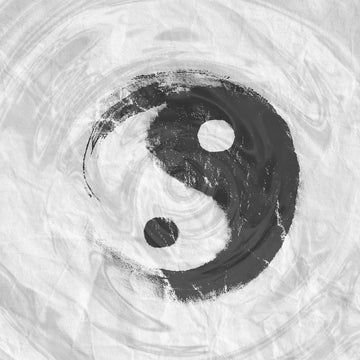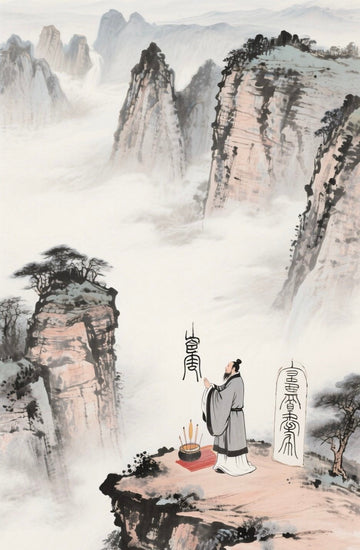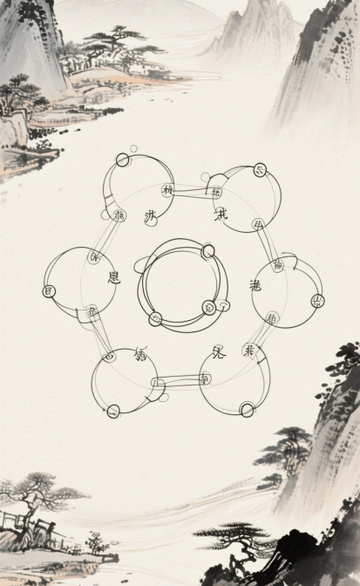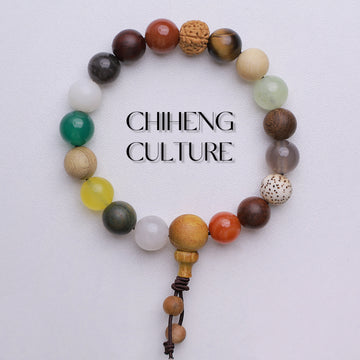In Taoist culture, "energy" is not an exclusive concept of modern science but a core proposition that permeates its cosmology, view of life, and cultivation system. From the Dao De Jing's assertion that "The Dao begets One; One begets Two; Two begets Three; Three begets all things" to the alchemical theories of the Zhouyi Cantongqi, Taoism has always centered around "Qi" to construct a comprehensive energy system that spans from the cosmic origin to life practice. This view of energy is not only a resplendent crystallization of Eastern wisdom but also radiates new vitality within the context of contemporary science.
I. Qi: The Ultimate Code of Cosmic Energy
Taoism posits that the essence of the universe is "Qi"—an innate, formless, and eternal energy. Transcending material forms, this energy serves as the origin of all cosmic phenomena and the foundation of life. In the Taoist classic Xingming Guizhi (Instructions on Spiritual Nature and Bodily Life), Qi is described as "the manifestation of the Dao," which "establishes heaven and earth and nurtures all things." It not only constitutes the fundamental particles of the physical world but also drives the operation of natural laws.
Remarkable parallels exist between modern scientific theories, such as quantum field theory and the hypothesis of dark energy, and Taoism's description of Qi. The wave - like properties of Qi (as captured by Kirlian photography) and its particle - like characteristics (similar to the "four - dimensional high - energy field" in Su Beijian's scientific system) echo the wave - particle duality in quantum mechanics, creating a dialogue across time and space.
Taoism regards the human body as a microcosm connected to cosmic energy through Qi. The Huangdi Neijing (Inner Canon of the Yellow Emperor) states, "Humans are in harmony with heaven and earth." The body's meridians and acupoints are essentially channels and nodes for Qi. When Qi flows smoothly within the body, the mind and body achieve harmony; conversely, blocked Qi can lead to illness and aging. Modern medicine has partially verified this "Qi - body" relationship: Acupuncture regulates bioelectricity by stimulating acupoints, and Tai Chi improves microcirculation through movement guidance, both of which are essentially methods of regulating Qi.
II. Energy Cultivation: Life Experiments from Inner Alchemy to External Practice
Taoist energy cultivation centers on the principle of "cultivating both nature and life," giving rise to a rich array of systems, including inner alchemy (Neidan), outer alchemy (Waidan), and breathing exercises (Fugi Daoyin). Inner alchemy treats the human body as a cauldron, converting essence, Qi, and spirit into higher - level energy through coordinated breathing, concentration, and movement. For instance, Tai Chi's practice of "guiding Qi with the mind and moving the body with Qi" achieves the 周天 circulation (circumference circulation) of Qi through dynamic guidance. Modern research shows that such exercises can optimize the coordination of the autonomic nervous system, enhancing cardiopulmonary function and stress resistance.
Although outer alchemy declined due to historical limitations, its core concept of "refining outer elixirs to supplement inner alchemy" reveals the profound logic of energy transformation. Ge Hong emphasized in Baopuzi (The Master Who Embraces Simplicity) that "medicines and foods share the same origin," advocating the use of natural herbs to harmonize the body's Qi field. Modern nutrition science has found that certain components of traditional Chinese medicine, such as ginsenosides and wolfberry polysaccharides, can enhance mitochondrial function and promote ATP production, aligning with the outer alchemy theory of "replenishing life force."
Breathing exercises directly absorb cosmic energy through specific respiration methods. For example, the "Turtle Breathing Method" mimics the slow breathing of turtles, reducing the metabolic rate to store energy; the "Embryonic Breathing Technique" activates the parasympathetic nervous system through breath - holding training, achieving the state of "sufficient innate Qi supplemented by acquired Qi." Infrared data showing a sudden increase in the crown chakra temperature when a Taoist monk in the Zhongnan Mountains passes away confirms the physical reality of this energy transformation.
III. Contending Schools: Diverse Interpretations of the Concept of Energy
Different Taoist schools exhibit distinct characteristics in energy cultivation. The Quanzhen School advocates "cultivating nature first, then life," enhancing spiritual energy through meditation. Its concept of "purity, tranquility, and non - action" closely resembles modern mindfulness therapy. Studies indicate that long - term meditators experience increased prefrontal cortex thickness and a significant reduction in anxiety levels.
The Zhengyi School focuses on "talismans and incantations," believing that talismans serve as a medium for communicating with cosmic energy. This "symbol - energy" connection can be explained in psychology as strengthening psychological suggestion through ritualized behavior, thereby regulating physiological states.
The Danding School's "cauldron theory" views the human body as a furnace for energy transformation. The sequence of "refining essence into Qi, refining Qi into spirit" aligns astonishingly with the modern sports physiology pathway of "energy metabolism optimization—neuromuscular coordination—psychophysiological integration." The Zhanyan School harmonizes environmental energy through divination techniques such as feng shui and numerology. Its "aura balance" theory has been partially validated in architectural psychology: a reasonable spatial layout can indeed influence human emotions and behavior.
IV. Modern Revelations: The Contemporary Transformation of the Concept of Energy
The Taoist concept of energy demonstrates unique value in contemporary society. In the field of mental health, the Taoist principle of "cultivating both nature and life" offers new approaches to treating depression. By harmonizing the mind and body through meditation and guidance, patients can reestablish energy balance. In one case, depressed patients adhering to Taoist health - preservation methods experienced a 28% reduction in cortisol levels and a 40% improvement in sleep quality.
In the management of chronic diseases, the fasting therapy activates the autophagy mechanism, enabling 80% of patients with stomach diseases to achieve "zero - point repair" and significantly improving insulin sensitivity in diabetic patients.
Taoist energy philosophy also provokes contemplation in the realm of science. Experiments on quantum entanglement at Tsinghua University have found that the focused consciousness of long - term Qi - gong practitioners can increase the coherence of photons by 23.7%, challenging the boundaries of classical physics. The description in Qiti Yuanliu (The Origin and Flow of Qi) that "the spirit can wander far beyond the body" echoes the phenomenon of "out - of - body experiences" in modern near - death research, suggesting that consciousness may be an energy form transcending matter.
Conclusion: Searching for the Key to Future Energy in Tradition
The Taoist concept of energy is, at its core, a profound insight into the relationship between life and the universe. From the philosophical speculation on Qi to the empirical practice of inner alchemy, from the diverse interpretations of energy by different schools to the cross - disciplinary verification of modern science, Taoism has always explored the mysteries of energy with an open attitude.
Today, as environmental pollution and spiritual crises intensify, this ancient wisdom provides a path back to the essence of life. By harmonizing the mind and body and conforming to nature, we can resonate with cosmic energy and ultimately achieve the life realm of "unity between man and nature." As the Dao De Jing states, "Man models himself after Earth; Earth models itself after Heaven; Heaven models itself after the Dao; the Dao models itself after nature." When we let go of our obsession with materiality and reexamine the Qi flowing within us, we may discover that the true energy revolution is embedded in our thousand - year - old cultural heritage.





